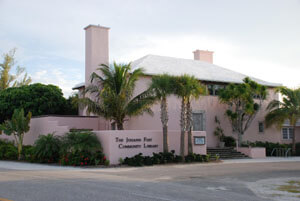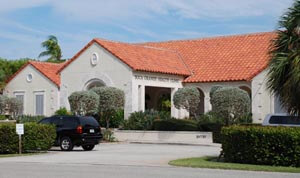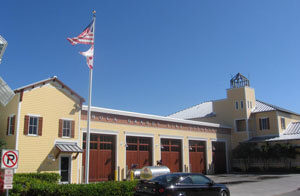Gasparilla Island’s first inhabitants were the Calusa Indians. They were living on nearby Useppa Island by 5,000 B.C. and on Gasparilla Island by 800 or 900 A.D.
Charlotte Harbor was the center of the Calusa Empire, which numbered thousands of people and hundreds of fishing villages. Nine Indian sites have been identified on Gasparilla Island and over 200 on nearby islands. These shell mounds often were 20 feet or more high; many are filled with pottery shards, fishhooks and arrowheads.
The Calusa were hunting and fishing people who perfected the art of maritime living in harmony with the environment. They were a politically powerful people, dominating Southwest Florida during their “golden age.”
History of the early fishermen settlers
 Just like the Indians, the earliest settlers came to Gasparilla Island to fish. By the late 1870s several fish ranches were operating in the Charlotte Harbor area. One of them would later be at the north end of Gasparilla Island in the small village called Gasparilla. The early Boca Grande fishermen, many of them Spanish or Cuban, caught huge catches of mullet and other fish and salted them down for shipment to Havana and other markets.
Just like the Indians, the earliest settlers came to Gasparilla Island to fish. By the late 1870s several fish ranches were operating in the Charlotte Harbor area. One of them would later be at the north end of Gasparilla Island in the small village called Gasparilla. The early Boca Grande fishermen, many of them Spanish or Cuban, caught huge catches of mullet and other fish and salted them down for shipment to Havana and other markets.
As time went on, and Boca Grande became known as a mecca for sportfishing, particularly tarpon fishing, many of these same families turned to guiding charters as a secondary, and later, as a primary income.
In the 1940s the Gasparilla Fishery was moved to Placida across the bay, where it still stands today, and the fishing village died out.
Today, many of Boca Grande’s early fishing families are still represented in third, fourth and even fifth generation descendants who pursue many different vocations, including fishing.
History: Boca Grande was put on the map by way of Phosphate and Tarpon
 In 1885 phosphate rock was discovered on the banks of the Peace River just above Punta Gorda, 20 miles to the east of Gasparilla Island across Charlotte Harbor. It was this discovery that would turn the south end of Gasparilla Island into a major deep water port (History Note: Boca Grande Pass is one of the deepest natural inlets in Florida) and become responsible for the development of the town of Boca Grande.
In 1885 phosphate rock was discovered on the banks of the Peace River just above Punta Gorda, 20 miles to the east of Gasparilla Island across Charlotte Harbor. It was this discovery that would turn the south end of Gasparilla Island into a major deep water port (History Note: Boca Grande Pass is one of the deepest natural inlets in Florida) and become responsible for the development of the town of Boca Grande.
At about this same time wealthy American and British sportsman began discovering the Charlotte Harbor area for its fantastic fishing (notably for the world class game fish tarpon) and hunting. It was these two discoveries – phosphate rock and fishing – that would put Boca Grande on the map.
Phosphate was a valuable mineral for fertilizers and many other products, and was in great demand worldwide. The American Agricultural and Chemical Company were organized in 1899 by the Bradleys of Boston and would come to dominate central Florida’s phosphate industry. At first the company barged the valuable mineral down the Peace River to Port Boca Grande and carrying the phosphate to it by rail should improve the method of, where it was loaded onto schooners for worldwide shipment. By 1905 it was felt that building a railroad to Port Boca Grande and carrying the phosphate to it by rail should improve the method of shipment.
In January of 1905 officials of the Agrico subsidiary Peace River Mining Company, along with engineers from the U.S. Engineering Corps and 60 laborers, landed on Gasparilla Island and surveying and construction of the railroad began.
The Charlotte Harbor and Northern Railroad was completed in 1907. In 1911 an automatic transloader was built at Port Boca Grande, the first of its kind for phosphate in the United States. For the next 50 years phosphate would be shipped out of the state-of-the-art port virtually without disruption. Phosphate laden trains were off loaded directly onto ocean going freighters, and the ships took the valuable commodity to ports all over the world. In 1969 Port Boca Grande ranked as the fourth busiest port in Florida.
In the 1970s phosphate companies increasingly switched their interest to ports in Tampa and Manatee County. As more money was put into developing these ports traffic into Port Boca Grande began to dwindle, and in 1979 the line was abandoned and the phosphate industry in Boca Grande came to an end.
History of the Boca Grande Railroad

The Charlotte Harbor and Northern Railroad not only brought phosphate and supplies to Gasparilla Island, it also brought wealthy people from the north. By 1910 Boca Grande Pass was already famous for its unequalled tarpon fishing among fishermen, who stayed at Mrs. Potter Palmer’s Useppa Inn on nearby Useppa Island. The railroad station in what would become downtown was built; roads, sidewalks, streetlights, shops, a post office, and water and telephone service were not far behind.
The Gasparilla Inn was completed in 1912. A few years later a casino was built near the hotel, and a boathouse on Boca Grande Bayou. The town was landscaped, including the now famous section of Second Street called Banyan Street. The railroad company built several cottages downtown and a few wealthy families from “up north,” notably the Francis B. Crowninshield family and the Harry F. DuPont family, purchased land and built winter residences on Gulf Blvd. at First Street.
In 1929 Joseph Spadero, an Italian immigrant to New York City built the Boca Grande Hotel just south of downtown Boca Grande. It was a three-story, brick resort hotel where most of the island weathered the hurricane of 1944. The Boca Grande Hotel changed hands and was demolished in 1975. It took 6 months to raze (by means of fire and the wrecking ball) the building, which had been built to withstand fire and great storms.
The Gasparilla Inn had become run down by 1930, when Barron G. Collier of Useppa Island and New York City purchased the Historical Hotel in Boca Grande. Later the Inn was auctioned off to a group headed by Bayard Sharp, who became sole owner. Today the Inn, with its 18-hole golf course and beautiful beach club on the Gulf of Mexico, is again an elegant hub of seasonal social activity. Its reputation for impeccable service is legendary and it is one of the largest employers on the island.
The railroad continued to bring the grand visitors from up and down the eastern seaboard until the Boca Grande Causeway opened in 1958. The railroad depot sat vacant for years until it was restored in the late 1970s and a number of shops, offices and The Loose Caboose Restaurant now occupy the venerable old building. The railroad continued to run work trains to the south end until the phosphate port closed in 1979. The Gasparilla Island Conservation and Improvement Association transformed the old bed of the railroad into a new use, Boca Grande’s popular bike path.
As the years went by, Boca Grande has continued as a unique community, with a large number of wealthy winter residents rubbing elbows with the fishermen and railroad and port workers who formed the permanent, year-round working class of the island. Islanders have worked together to provide a combination of facilities and organizations that make Boca Grande a unique island community.
 The Community Center History
The Community Center History
The building that is today the Boca Grande Community Center (at the corner of Park Avenue and First Street) was Boca Grande’s school. It was designed in 1929 and built by the citizens of the town. For 35 years the classrooms were filled with students aged 5 to 18. Once the Boca Grande Causeway was opened the school was closed in 1963. Island children now have access to schools on the nearby mainland in Charlotte County. A new addition provides classrooms for an Island Charter School.
In the early 1970s local citizens organized to convert the school into a center for educational, cultural programs and activities for the community. Today, a large and diverse group of volunteers, “The Friends of Boca Grande” provide major financial and technical support for the Boca Grande Community Center.
The Library History
 At the corner of Tenth Street and Gasparilla Road is a lovely pink stucco building. This is the Johann Fust Community Library, a gift to the people of Boca Grande by winter residents Mr. and Mrs. Roger Amory. The Amory’s once operated a floating library, which carried newspapers, magazines and books to neighboring islands.
At the corner of Tenth Street and Gasparilla Road is a lovely pink stucco building. This is the Johann Fust Community Library, a gift to the people of Boca Grande by winter residents Mr. and Mrs. Roger Amory. The Amory’s once operated a floating library, which carried newspapers, magazines and books to neighboring islands.
Johann Fust is the German gentleman who financed Gutenberg’s invention of the printing press and the first printed book, the Gutenberg Bible.
Built in 1949, the Historical Boca Grande library, which houses 10,000 volumes, features 10-foot carved cypress doors copied from a pair in Constantiople. Walk through the cool arcade of native coquina and cypress into an open-air loggia and relax for a while beside the charming fountain and lovely gardens.
Two graceful 18th century Japanese cranes adorn the entryway to the main book collection. Also on display is an extensive shell collection, which Henry Francis Dupont amassed over nearly 50 years of island shell collecting. George Malasics has also contributed to this extensive collection.
 Boca Grande Medical Services History
Boca Grande Medical Services History
Medical Care in Boca Grande is available at the Boca Grande Health Clinic, which was founded 1946, is located at the corner of Park Avenue and Third Street in downtown Boca Grande.
The clinic is housed in a lovely Mediterranean style building, which was built entirely through private contributions in 1990 and continues to add enhanced facilities and viability through its foundation.
Essential Services
Sheriff and EMS services are provided by Lee County with inter-local agreements and services on the Charlotte County portion of the island provided by Charlotte County.
 Fire – Boca Grande is an independent fire control district, which provides service to the entire island with back up provided by Charlotte County Fire and EMS. The Boca Grande Fire Control District constructed a public safety building in the village, which also provides space for the Sheriff and Emergency Medical Service. The fire district has three elected commissioners who live on the island and serve.
Fire – Boca Grande is an independent fire control district, which provides service to the entire island with back up provided by Charlotte County Fire and EMS. The Boca Grande Fire Control District constructed a public safety building in the village, which also provides space for the Sheriff and Emergency Medical Service. The fire district has three elected commissioners who live on the island and serve.
Water & Sewer – Boca Grande has its own water and sewer system operated by Gasparilla Island Water Association (GIWA). Islanders serve on the administrative board and operate the system, which has a sewer treatment plant, well fields off the island and a reverse osmosis plant.
The out island spirit continues as many volunteers endure to maintain the unique island charm that attracted our early visitors. This collaboration makes every islander and visitor a stakeholder and is the cohesion that makes Boca Grande a special place.
(Excerpts Taken from Boca Beacon Visitor’s Guide – 1997)

Boca Grande Real Estate, Inc.
Downtown Office
430 W. 4th Street #686, Boca Grande, Florida 33921
941-964-0338
North Office
5800 Gasparilla Rd. Unit C4, Boca Grande, FL 33921
941-964-0987
